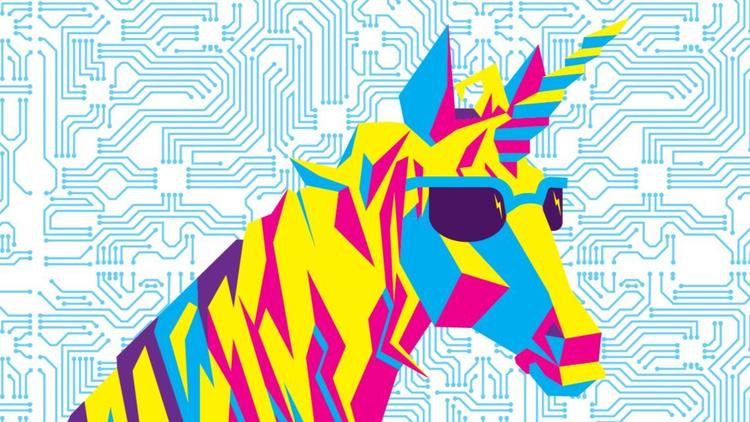
What’s behind San Diego’s thriving tech scene and new wave of “unicorns”
Mar 11, 2019 -
We’ve talked a lot about San Diego’s burgeoning tech scene.
But here’s a little-known secret about San Diego: We’re not a one-trick town. We’ve got surf and science, breweries and biotech. And whether we’re racking in record research dollars, raising VC, or making waves, our rapidly-growing club of San Diego unicorns across all industries means our secret is out. Read all about San Diego’s newest unicorns in 2021.
Plus, check out the San Diego Union Tribune article below to learn about the exponential history of San Diego startups:
San Diego is a biotech town, a military town, and a tourism town. It’s not a software town, is it?
After years of stagnation, San Diego is seeing a barrage of startup activity in the tech scene. In recent months, two tech startups earned billion-dollar valuations, making them the first software “unicorns” spotted locally in decades. Seismic won the title in late December, while TuSimple — only 4 years old — reached unicorn status last month.
The news caps months of unusually high venture capital deals in local tech, with at least $320 million funneling into tech startups in less than three months. For context, tech companies only brought in $164 million combined for the first nine months of 2018. Once a ghost town for tech investors, San Diego just became home to two new VC groups: Blueprint Equity and Torrent Ventures. The region also piqued the interest of larger investor groups like PeakSpan Capital, which just closed a $265 million fund and has recently invested in six San Diego companies.
The bubbling activity is bewildering to some in the business community, who long ago acclimated to the idea that San Diego is a place where science rules supreme, while software tends to flounder. And it’s true the biotech industry still rakes in the lion’s share of venture money. But San Diego’s tech scene is not what it used to be, and new players are coalescing into a hub with considerable speed.
What is a tech ‘unicorn’?
A privately held startup valued at over $1 billion. Once as rare as a unicorn, sightings are increasingly common. There over 300 unicorns worldwide, roughly half of which are based in the US.
Why did San Diego miss the last train of tech unicorns
There’s no denying that this traction is new. When internet-age software took off in Silicon Valley, San Diego wasn’t even trying to catch the train. Fast-moving startups like Uber and Airbnb built empires by merely taking existing businesses — taxis and hospitality, for example — and tailoring them for the smartphone age. Leveraging the explosion of mobile phones and cheap cloud computing, they ballooned from babies to giants in record time. And so a wave of tech startups followed suit, picking off low-hanging fruit by bringing the world’s old businesses online. Square tackled point-of-sale systems, Lending Club took banking, and so on.
In this wave of tech, San Diego largely didn’t come out to play. Eric Otterson, who’s been entrenched in local tech for the past two decades as managing director of Silicon Valley Bank, said the city’s culture at the time was likely to blame. After the dot-com bust left technologists disillusioned, San Diego suffered an additional blow in the early 2000s — the implosion of Peregrine Systems, one of the city’s most successful software companies at the time. Massive fraud charges crumbled the enterprise, and 1,400 people lost their jobs. Experienced engineers and upper management either ended up in Silicon Valley or at companies like Qualcomm and WebSense, where low-risk culture is king.
“These are companies whose product lead time and criticality required six-sigma processes (no room for errors) and very low-risk cultures,” said Otterson, managing director of Silicon Valley Bank. “This was unlike the prevailing high-risk behavior in software companies up north, where the idea was to get the product out, then ask for forgiveness and upload a patch later.”
Low-risk culture extends beyond San Diego’s tech giants, though. The city’s most established industries — life science and defense — are anything but fast moving. If Facebook’s strategy is “move fast and break things,” San Diego’s is something like: “slow down, buddy … and don’t break anything.”
San Diego’s tech culture remained sluggish for a decade after Peregrine’s collapse, until the rise of ServiceNow. That company was one of the first to the software-as-a-service trend, and they grew fast as a result. But after raising more than $80 million in growth capital, the startup decided to relocate its headquarters to Silicon Valley.
The departure of ServiceNow’s executive team became a sore point among local tech entrepreneurs, who pointed to it as an illustration of San Diego’s failure to support a unicorn’s growth.
“When successful software companies died or moved, it was a big blow because there weren’t a lot of others to take their place,” said Doug Winter, CEO of Seismic.
Today, ServiceNow is a public company with a $43 billion valuation. For context, San Diego’s lauded tech giant Qualcomm is valued at $64 billion. Such successes are rare, and San Diego missed an opportunity to have a software anchor at home.
What changed in San Diego?
Over the past five years, however, the tech scene started to percolate. A group of ragtag software founders — many of whom were in their 20s and 30s — started a volunteer-led organization called Startup San Diego to try and rally a community around tech. Their first annual gathering only attracted a couple hundred people in 2012. Last year, however, they’d grown San Diego Startup Week to over 4,400 attendees.
Combine that with waves made by Mike Krenn, the popular president of San Diego Venture Group, since he took the job in 2014. As one of only two employees at the nonprofit, Krenn has launched multiple loud marketing campaigns to boost the technology brand of San Diego. He opened an office in the heart of San Francisco’s business district and offered it up as a beachhead for San Diego entrepreneurs pitching VCs in the valley. The effort was backed by the City of San Diego with a $20,000 check.
And in 2016, Krenn launched a campaign to steal talented engineers from Silicon Valley, which included a digital billboard on one of the Bay Area’s busiest (and most gridlocked) freeways. The sign baited technology workers with one-liners like “Today’s surf report: San Diego is better.” There’s no way to measure how effective that campaign was at relocating tech talent to the region. However, the young venture capitalists at Blueprint Equity recently cited Krenn’s efforts as influential in their decision to locate a new $50 million tech fund in San Diego.
The support for a startup community in San Diego is mirroring local economies all over the globe, as cities attempt to replicate Silicon Valley’s success. Startup Week events, for example, are popping up in every major city. But a series of events in San Diego primed the economy for a sudden uptick in startup growth.
Otterson points to a couple of timely layoffs at major companies like Qualcomm during 2015, which unloaded a pool of talent into the ecosystem.
“A younger workforce started to think the risk of jumping out to do your own thing was comparatively more interesting,” Otterson said. And with companies like WebSense and Active Network moving jobs out of the city, there was now a ready workforce of engineers to join them. Out of tech giants like Qualcomm and ServiceNow came the founders of some of San Diego’s best-known startups: HouseCall, Netradyne, RockMyWorld, Dreamtsoft, Yembo, and many others.
These local catalysts had impeccable timing, however, and there’s no doubt that macroeconomic factors played a huge part in San Diego’s technology surge.
How macro forces shaped San Diego’s tech scene
Layoffs at major tech corporations happened during a period of strong economic recovery. Unemployment is at an all-time low and knowledge workers — especially those working in technology and engineering — are in high demand. It’s not scary to work for an unpredictable tech startup when job offers are piling up on LinkedIn. If the company goes under, workers can jump to the next opportunity.
“The whole ecosystem throughout North America is very healthy,” said Paul Barber, a tech venture capitalist at JMI Equity who invests in startups all over the country. “We’re seeing the lowest employment rate in 50 years, especially for those college-educated in tech.”
The demand for workers has driven tech giants like Google, Amazon and Walmart to establish satellite offices in new cities, including San Diego.
“For these companies to grow, they can’t do everything in one location,” Barber said. “There’s not unlimited talent.”
The expansion of these legacy companies into secondary markets like San Diego primes the city for startup growth, according to Winter, Barber, and Otterson.
“The larger, experienced companies provide training that feeds the growing needs of our local companies, both for engineers and sales teams,” Otterson said.
How advancements in technology played a role
Economic factors aside, the tech scene’s growth in San Diego (and worldwide) has much to do with the evolution of software itself. Thanks to cloud technologies like Amazon Web Services, Microsoft’s Azure and IBM Cloud, companies are less expensive to get off the ground.
“Those three things alone have virtually eliminated half our problem,” said Jerrod Bennett, co-founder of Dreamtsoft and ex-ServiceNow architect. “Even 15 years ago, you had to stand up whole data centers and server farms to get a product from ideation to prototype. And that’s just the computers. Today, you can be a software entrepreneur with just a laptop.”
This accessibility has democratized technology, allowing eager entrepreneurs in any city to get started on their ideas. From here, many seek growth capital from startup investors to fund their early development.
San Diego’s dearth of VCs — especially in tech — is well-documented and a near-constant topic among local entrepreneurs. But even that is starting to change.
“The success of Silicon Valley has created huge pressure on wages, housing and infrastructure, and many people don’t want to be in that game,” Barber said. “The Bay Area is still thriving, but its success makes places like San Diego, Austin and Denver attractive because costs are lower there.”
To be clear, San Diego’s tech scene has a long way to go. It does not rival powerhouse cities like San Francisco or New York, nor is the local tech scene growing as rapidly as fledgling tech hubs like Austin. But as they say in business, “you should only compare yourself to who you were yesterday.” For San Diego, the traction in tech is a big leap from where the startup scene has been.
How to keep San Diego’s momentum going
San Diego has two distinct advantages as a new startup city: it’s a nice place to live and it’s only a one-hour flight to San Francisco. In the Internet-age — in which software entrepreneurs can work and live anywhere — these factors matter.
“When all the barriers to starting a company are broken down, all that’s left is to ask ourselves is: where do we prefer to be?” Bennett said. “And San Diego ranks high on that list.”
The city’s pleasant weather was the cornerstone of a popular new campaign to attract millennial tech and science talent from competitor cities. The new campaign, paid for by the San Diego Regional Economic Development Corp., targeted cities experiencing brutal winters this year, such as Boston and New York City.
But San Diego needs to do more than advertise the city’s most obvious assets if it wants to keep up the momentum, Barber said. The city’s business community should welcome outside companies like Apple and Google who are opening satellite locations in San Diego, and not disown companies like ServiceNow who moved their executive teams but maintain a large presence here.
“Big companies of the future will be multi-site,” Barber said. “Whether their headquartered here or not isn’t important anymore. We need these companies, because they’ll hire and train entrepreneurs for the next 10 years. We should be welcoming them with open arms.”
Winter added that business leaders should also start thinking of San Diego as more than a biotech town.
“Software is the next big wave for the global economy in general,” Winter said. “If San Diego wants to stay near the front and be a great place to live, then we should be encouraging and nurturing the software industry. Just like you don’t put all your money in one stock, a city should diversify its industries of focus.”
Read original article by Brittany Meiling here.
Photo from Michelle Guerrero | San Diego Union Tribune


